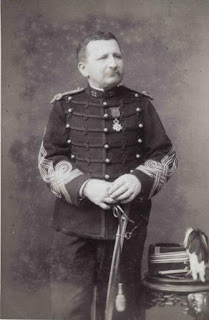The beautiful palace of Fontainebleau was the scene of one of Péchot's early triumphs. First of all, you may wonder why Fontainebleau?
From the 12th century, there has been a royal chàteau as the place was both congenial and relatively close to Paris, with the river Seine flowing close by. King François 1, Henri IV and Napoleon III were among the famous residents. The village of Fontainebleau reflected the importance of the chàteau. Kings and emperors have long gone, but national institutions still have their place, eg INSEAD (a grande école) and an Army training school. Imagine, if you like, a huge country house containing an Oxbridge College and Sandhurst, with a delightful little town attached.
 |
| Photo Courtesy Luxury Chic Travel |
Prosper Péchot came to Fontainebleau just after the Franco-Prussian War. It was 1872, just after a bruising year. In 1871, he and his comrades had expended their all, only to be defeated. He, personally, had lost his father and an uncle in the aftermath. His brother was recovering from a bad wound. To a person as family minded as young Péchot, this was truly terrible. As part of his training, he should have been going to military college in Metz, but, yet another little wound, Metz was in the Lost Provinces, ceded to Germany. Officer training had been hastily moved to Fontainbleau.
So far, the story is sad.
 |
| Prosper Péchot in 1907 Photo courtesy Raymond PECHOT |
Péchot was able to channel his hurt and anger, not just into being a good officer and family man (marriage came in 1877) but into a plan to defeat the German Army! As he explained in his Memorandum to the Minister of Defence (1882), defence alone would not defeat the enemy. The Germans had to be attacked, with the heaviest guns that were available. These were useless until they were within range of the enemy's defences and supplied with adequate ammunition. Only a narrow gauge railway - 60cm/2' gauge - could move the tonnages required quickly enough. The Festiniog railway of Wales showed that this was possible. With some help from Paul Decauville, the prominent industrialist, Prosper Péchot designed a system which made it practical.
 |
| At the heart of the Péchot system was the design of portable prefabricated track. Improving on existing technology, lengths of track could be carried into position, laid on country paths and yet could support axle-loadings of up to 3.5 tonnes. From Decauville catalogue, illustration courtesy J. Hawkesworth |
All that remained was to persuade his superiors of the merits of his case. This was not easy; Péchot had made the mistake of costing out his scheme - there was a rival metre gauge scheme which was uncosted and so the pen-pushers decided that this rival scheme must be cheaper! By 1885, the 'système Péchot' had been officially dropped, by the Army at least.
The military school at Fontainebleau, however, was not privy to Army rivalries. In the winter of 1885, they approached Péchot and explained their problem. They had been holding summer exercises, 'attacking' a putting green just outside Fontainebleau and and 'investing' it with a 240mm gun. The exercise sounds like a delightful game until you see the site. The Mail Henri IV occupies a steep hill about a kilometre from the Palace buildings and, even when dis-assembled into components, the gun weighed 15 tonnes. The previous year, dragging a gun half the size up the slope had taken over a week.
 |
Fontainebleau: From the area that is not bounded by town or garden, the students and Péchot set off up the hill with their 15 tonne gun. Image courtesy Napoleon Tours
Working in his spare time, Péchot gave the students his enthusiastic support. Existing prefabricated portable 60cm track was collected up and special new bogie wagons were manufactured. The supporting bogies each had six wheels - three axles - each capable of supporting 3.5 tonnes' mass without causing the rail to distort. This gave the wagon a theoretical load-limit of 21 tonnes, more than adequate for the gun barrel it was to carry. With the help of block-and-tackle fixed to suitable trees, the wagon could be winched up the steepest parts of the route.
On July 27th, 1886, Péchot was permitted some leave and arrived at Fontainebleau early, in time for the exercise. In the courtyard of the Military College, prefabricated track was laid out for the bogie wagon. With the help of a crane, the gun barrel was loaded on the wagon. It was harnessed to the waiting horses, and off they went. The help of the marines was needed when the gun was winched up particularly steep slopes, and when they came to a bend. Curved track and turnouts had still to be introduced and so they used turntables.
Lunchtime had to be spent on the hill, but Mail Henri IV was successfully invested within seven hours. Dinner could be punctual - thank goodness!
From that point, the Péchot system could not be ignored. In 1888, it was made the official railway for the frontier fortress towns of Verdun, Toul, Épinal and Belfort, in 1889, an officially apoproved gauge for public carriers within France. Also in 1888, the German Army abandoned its existing experiments and introduced a military system, the Feldbahn, which was suspiciously similar to the French one. The rest, as they say, was history which you can follow in my book, 'Colonel Péchot: Tracks To The Trenches'
|



